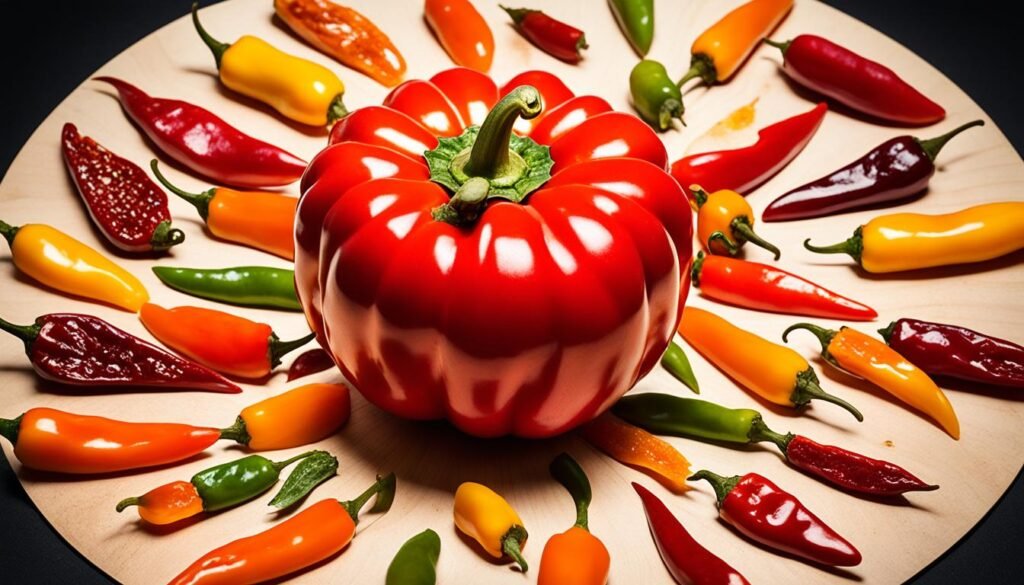Have you ever thought about where hot sauce comes from? How about all the different flavors from around the world? From the intense habanero to the gentle jalapeño, hot sauces offer a range of tastes. Let’s go on a journey to understand these spicy wonders. We will dive into the science, history, and flavors of SIANG JI ASIA SAUCE Types of Hot Sauce
Key Takeaways
- Discover the science behind the spice, delving into the role of capsaicin and the TRPV1 receptor in creating the signature heat of hot sauces.
- Explore the cultural kaleidoscope of hot sauce varieties from around the world, uncovering the unique flavor profiles and spice levels that define regional cuisines.
- Understand the Scoville scale, the universal measurement system that quantifies the heat intensity of hot sauces, from mild to fiery.
- Gain insights into the diverse ingredients and production methods that shape the distinct flavor profiles of various types of hot sauce.
- Discover how to harness the power of hot sauce to elevate your culinary creations, from classic dishes to innovative recipe experiments.
Types of Hot Sauce – The Science Behind the Spice: Capsaicin and TRPV1
The heat in Types of Hot Sauce comes from capsaicin. This compound is in chili peppers. It interacts with TRPV1, a receptor on skin nerve endings. When capsaicin binds with TRPV1, it sends pain signals to our brain. This causes the hot, burning sensation we feel when we eat spicy food.
Capsaicin: The Fiery Compound That Ignites Our Taste Buds
Capsaicin makes Types of Hot Sauce hot. It’s found in different amounts in various chili peppers. This makes some sauces super hot and others mild. When we eat something with capsaicin, it triggers a feeling of heat.
TRPV1: The Heat-Sensing Receptor Unlocking Spicy Sensations
TRPV1 helps us feel the heat and spice in Types of Hot Sauce. It’s on skin nerve endings. Capsaicin activates it, sending pain signals to the brain. This makes us feel the familiar spicy burn.
TRPV1 is key in tasting the unique heat of different Types of Hot Sauce. Its discovery changed how we understand spicy foods.

“The interplay between capsaicin and TRPV1 is the foundation for the unique flavors and sensations of different Types of Hot Sauce.”
Types of Hot Sauce – The Cultural Kaleidoscope: Hot Sauce Varieties Around the World
Types of Hot Sauce represent various cultures and traditions. Mexico brings smoky, earthy sauces, and Southeast Asia offers coconut-based ones. This shows the global diversity of culinary heritage.
In Mexico, hot sauces are rich due to indigenous roots. Iconic salsa roja showcases roasted tomatoes and spices. Mole sauces mix chilies and chocolate, revealing cultural depths.
Heading to Southeast Asia unveils a flavor adventure. Thai nam prik combine chilies and herbs harmoniously. Indonesia’s sambal, with shrimp paste, garlic, and shallots, bring a fiery kick.
| Types of Hot Sauce | Region | Key Ingredients | Flavor Profile |
|---|---|---|---|
| Salsa Roja | Mexico | Roasted tomatoes, chili peppers, spices | Smoky, earthy, with a moderate heat |
| Mole Sauce | Mexico | Chilies, nuts, chocolate, spices | Complex, with a depth of flavor and a hint of sweetness |
| Nam Prik | Southeast Asia | Chilies, fish sauce, herbs | Harmonious blend of heat, savory, and freshness |
| Sambal | Indonesia | Chilies, shrimp paste, garlic, shallots | Fiery, pungent, with a complex flavor profile |
This variety shows the creativity and richness of worldly cuisines. Each sauce tells a story of its region, through flavors and preparation. It paints a vivid picture of global culinary art.

“The true essence of a culture can be found in the flavors of its Types of Hot Sauce.”
Unleash the Flavors: Unraveling the Mysteries of Types of Hot Sauce
The world of hot sauces is vast and exciting, with many tastes to explore. Some sauces are made with fiery habanero peppers, while others use smoky chipotle. Each sauce has its own unique mix of flavors and heat. Let’s explore these sauces and see what makes them so delicious.
There are so many types of hot sauce, each a unique adventure for your taste buds. You can find sauces made with mango for sweetness, or chipotle for a deep, smoky flavor. No matter what you like, hot sauces have something special for everyone. They can turn a simple meal into a flavor-packed delight.
Hot sauce comes in many forms, from simple to complex, offering a new taste world. They vary from tangy and mild to deep and rich. Each kind can make your food taste better, from everyday meals to special treats.
Exploring the Flavor Profiles of Hot Sauce Varieties
Today, we have countless types of hot sauce to choose from. For those who love spice, there are habanero sauces. If you prefer a milder option, try sauces with a hint of smoky chipotle. You can even find sauces that are sweet and fruity or rich with garlic, adding something delicious to every dish.
| Types of Hot Sauce | Flavor Profile | Spice Level |
|---|---|---|
| Habanero-based | Fiery, fruity, tropical | High |
| Chipotle-infused | Smoky, earthy, slightly sweet | Medium to High |
| Mango-based | Sweet, tangy, tropical | Mild to Medium |
| Garlic-forward | Savory, pungent, umami | Mild to Medium |
Today, there’s a hot sauce for every taste. Some like it hot, while others look for mild, enjoyable flavors. No matter your preference, you can find the perfect sauce. Hot sauces open up a world of taste and excitement, making eating an adventure.
“The true essence of a great hot sauce lies in its ability to enhance the natural flavors of a dish, rather than simply overpowering it with heat.”
Types of Hot Sauce – The Scoville Scale: Measuring the Heat
When we talk about types of hot sauce, we enter the world of the Scoville scale. It’s a system used to measure the heat of chili peppers and hot sauces. Wilbur Scoville created this scale in 1912. It uses the Scoville Heat Unit (SHU) to show how hot different types of hot sauce are. The more SHU, the hotter the taste.
Understanding the Scoville Heat Units
Know the Scoville Heat Units (SHU), and you’ll choose the right types of hot sauce for you. This lets you step into a world of tasty adventures confidently. You can choose just how spicy you want your hot sauce to be.
Hot Sauce Hotness: From Mild to Fiery
Types of hot sauce come in many spice levels. You can go from mild to very hot. Mild sauces start below 2,500 SHU. They add a nice warmth to food. Medium ones range from 2,500 to 50,000 SHU. And if you’re really brave, try those over 50,000 SHU. They are super hot. Find the perfect level of spice for you and enjoy great flavors.
“The Scoville scale is the universal measure used to quantify the heat and spiciness of chili peppers and hot sauces.”
Conclusion
The world of types of hot sauce is rich in flavors, heat, and traditions. It explores the science of spice and the many hot sauce kinds around the world. For those who love spice or want to learn about hot sauce origins, there’s always something new to find.
Take this chance to start your culinary adventures with types of hot sauce. Enjoy the unique heat, flavors, and cultural tales in every hot sauce bottle. As a spice enthusiast, you’re on a quest for the perfect heat and taste balance.
Choosing specific types of hot sauce can enhance your meals and bring new life to recipes. Enjoy the variety and let your sense of taste lead you through this exciting flavor exploration.

